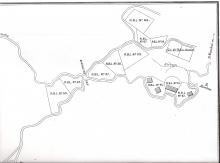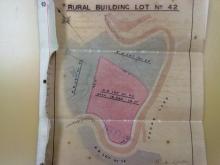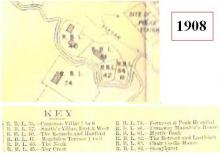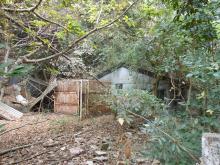23 Coombe Road aka Stonyhurst/Glen Iris/Carrick - also 528 The Peak [1887- ]
Primary tabs
The house now known as ‘Carrick’ at No. 23 Coombe Road (which falls on Rural Building Lot 731) was constructed in 1887. It was obviously designed as a private luxury house used for residential purpose. Its first owner was John Joseph Francis (1839-1901), or J.J. Francis, as he preferred to be known. J.J. Francis purchased the plot of land on No. 23 Coombe Road in March 1886. In the following year he had his house, which he called ‘Stonyhurst’, built on the site. The house was named after Stonyhurst College in Lancashire, England, where he had been educated and intended for the Roman Catholic priesthood. The house was renamed as ‘Glen Iris’ in 1919 and it was so called until 1972/73 when it was renamed as ‘Carrick’ – a name that has been adopted since then. Born in Dublin (Ireland), J.J. Francis came to Hong Kong as a military officer in the 1860s. He was admitted as a solicitor in January 1869, then as a barrister in April 1877. Shortly after his own admission to the Hong Kong Bar, he signed an affidavit in support of the application of Ng Choy (伍才) (1842–1922), the first Chinese to be admitted to practise in Hong Kong. Ng Choy, otherwise known as Wu Ting-fang (伍廷芳), was the first unofficial Chinese member of the Legislative Council who later joined the Chinese administration as a diplomat. In April 1879, J.J. Francis was appointed Puisne Judge of the Supreme Court. In February 1886 he was appointed as Queen’s Counsel (Q.C.) and became the third barrister on whom the honour had been conferred in Hong Kong. J.J. Francis was prominent in civic affairs in a number of respects. In 1878 Governor Sir J.P. Hennessy appointed a committee of four (including C.V. Creagh, W.M. Deane, E.J. Eitel, J.J. Francis) to investigate the issue of mui-tsai (妹仔, indentured Chinese girls working as unpaid domestic servants). This committee recommended the constitution of a Chinese association for the protection of women and girls. As a leading barrister and Queen’s Counsel, J.J. Francis is remembered in the history of Hong Kong for drawing up the rules for enacting the formation of the said association (i.e. Po Leung Kuk Incorporation Ordinance). Set up in 1878, the said association adopted the Chinese name Po Leung Kuk (保良局) and is still active in Hong Kong today. J.J. Francis’ name was sinologised in the Po Leung Kuk Archives as 法蘭些士or 佛蘭些士. The best part of J.J. Francis’ life came after he purchased the plot of land on Coombe Road and built ‘Stonyhurst’. He served on the Finance Committee of the Alice Memorial Hospital (雅麗氏紀念醫院), founded by a prominent Chinese, Dr. Ho Kai (何啟) (1859–1914) and opened in 1887. In the same year he was appointed as standing counsel for the Hong Kong College of Medicine (香港西醫書院, “the College”) where Dr Sun Yat-sen (孫逸仙) (1866–1925) took up his medical studies. J.J. Francis was on the platform at the first graduate ceremony of the College, held in the City Hall on 23 July 1892. On his death the Court of the College passed a resolution expressing appreciation for his services. When bubonic plague attacked Hong Kong in May 1894 the Sanitary Board (潔淨局) formed a committee of three, with J.J. Francis as chairman, to cope with the emergency. In 1895, the Governor Sir William Robinson sent him a silver inkstand as a commemoration for his services during the plague. J.J. Francis added to his popularity with the community in general by lecturing on various subjects in the Chamber of Commerce and the City Hall, the topics of his lectures ranged from Jesuitism (in 1872) to the Crown Colonies (in 1889). He was, at one time, editor and proprietor of the English local newspaper The China Mail (德臣西報). His name was also identified with the Odd Volumes Society, the Navy League and the China Association, of which he was the local branch chairman at the time of his death. His funeral on 30 October 1901 took place at the Roman Catholic Cemetery at Happy Valley. The Right Rev. Bishop Piazzoli (和主教) conducted the funeral service, among those present being the then Colonial Secretary James Stewart Lockhart (駱克), Sir Thomas Jackson (昃臣), Hon. C.P Chater (遮打) and Dr. Ho Kai. No. 23 Coombe Road changed hands a number of times in the past. Its owners were, in succession, J.J. Francis (1886-1901), The China Fire Insurance Co. Ltd. 中華火燭保險行 (1901-1903), Ahmet Rumjahn (1903-1910), J.J.B. (1910-1918), D.V. Falcorner (1918-1921), The Hongkong Electric Co. Ltd. 香 港電燈有限公司 (1921-1976), Cavendish Property Development Ltd. (1976-1993) and then Juli May Ltd. The aforesaid Ahmet Rumjahn was a broker and estate agent conveying on business on Hong Kong Island; himself an Indian Muslim, he served as a member of the Sanitary Board in 1905 along with British board members and several Chinese. The two-storey house at No. 23 Coombe was designed in classical style by an architectural firm called Danby & Leigh. When James Orange joined in 1890, the firm was renamed Danby, Leigh & Orange, which evolved into Leigh & Orange when William Danby left the firm in 1894. The house is built on a platform supported by a retaining wall topped by a classical style parapet. The first floor (piano nobile) level is accessed through a portico reached by a flight of external steps flanked by stepped planters, and there is a porch over the landing at the top of the steps. Though modest in scale, the house has a traditional piano nobile at 1/F level and a service floor at G/F level with external ornamental classical features typical of Palladian villas. Palladianism became popular in England from the mid-17th century and in other parts of Europe, e.g. Ireland where the house’s first owner came from. Later when the style was falling from favour in Europe, it had a surge in popularity throughout the British colonies. The elevations of the house are divided into bays by rusticated piers or pilasters. The corners of the building have stucco groins. Moulded stucco bands run around the building. The ground floor windows are smaller than the first floor windows with curved heads and deep reveals. The wide first floor windows have plain segmental arches with central keystones. The walls are finished with painted rough cast rendering. A moulded cornice runs all around the house at eaves level. ‘Stonyhurst’ bears witness to a historical period when the coolies’ labour was much needed in the construction of buildings in Hong Kong. In 1889, two years after the completed of ‘Stonyhurst’, the Governor Sir George William Des Voeux described the building of houses on the Peak in these words: “every brick, stone, timber, and other article used in construction, as well as the furniture on completion, requires to be carried on coolies’ shoulders for distances varying from one to two miles to a height of 1,100 to 1,600 feet”. Before the construction of ‘Stonyhurst’ in 1887, J.J. Francis had lived at a number of Hong Kong addresses which included Mosque Street, Alexandra Terrace, Caine Road, Bonham Road and Seymour Terrace. At present, the only remaining building in which he lived is ‘Stonyhurst’, a piece of architecture with built heritage value. No. 23 Coombe Road is one of the oldest surviving European houses on the Peak. It was built in 1887, when the Peak could boast of hardly more than a few houses. At the time the Peak Tramway was not yet opened for public. The Mid-Levels were then struggling to attract residents, May Road being but a footpath, and Caine Road considered fairly high up.





Comments
AMO Seeking Comment
Antiquitities and Monuments Office seeking comments on provisional grade 3 - I'd suggest that's quite low for one of the only surviving Victorian houses on the Peak. Comment, send them pictures, persuade them to raise it:
Public Views Invited on the Assessment Result of No. 23 Coombe Road, The Peak
From now until 21 January 2011, members of the public are invited to express their views on the assessment result of No. 23 Coombe Road, The Peak and/ or provide additional information on the concerned building, if any, by writing to the Antiquities and Monuments Office via:
http://www.amo.gov.hk/en/aab_1_1.php
Demolition Permit
ah the real reason comes out; Buildings Department has approved plan for new building on the site according to this from Oct. 2010. Applicant is Juli May Ltd. whoever they are - house was previously available for lease from Hutchison Whampoa. I don't know if the two companies are connected.
http://www.bd.gov.hk/english/documents/statistic/Md53e.pdf
http://www.hwpg.com/en/properties/p14.asp
stonyhurst
was RBL 84 according to annelise's list of houses from 1915 directory
Stonyhurst
1888 map
stonyhurst
Brilliant work Annelise, thought you'd find some good stuff. Do we know how many houses had been built on the Peak by the time this was built (ie how original is it) and are there any older than this still on the Peak? It would be a tragedy if this was demolished for another garish marble block.
I wonder who J.J.B. was?
John Joseph Francis
There's a detailed mini-biography of JJ Francis (29 pages) linked below published by Walter Greenwood in 1986, which expresses surprise that Francis was never commemorated with a street name etc.
Even back then he describes Stonyhurst as a fine house which must be one of the oldest European houses in Hong Kong.
Greenwood says Francis also built Magdalen Terrace next door, possibly named after his second wife. Long gone, the Terrace is now 21 Coombe Road blocks A and B.
sunzi.lib.hku.hk/hkjo/view/44/4401590.pdf
I've sent this email to the
I've sent this email to the AMO.
Dear AMO,
I refer to the historical information I have collected for RBL 41, 42 and 84 and the houses names Magdalen Terrace, Stonyhurst, Glen Iris and Carrick I have posted at http://gwulo.com/node/7736#comment-15603 and also http://sunzi.lib.hku.hk/hkjo/view/44/4401590.pdf
From the map dated 1888:
- RBL 41 - a building named Magdalen Terrace
- RBL 42 - a building named Stonyhurst
The rates book apparently corrected an error in 1889 and correctly placed Stonyhurst on RBL 42 in that year.
In 1890 we have the following in the Peak Directory, Directory and Chronicle for China, etc. (http://gwulo.com/node/7064)
1890 1, Magdalen Terrace - Francis, J. J.
1890 2, Magdalen Terrace - Melbye, E.
1890 3, Magdalen Terrace - Lind, A.
1890 Stonyhurst - Dowler, H. G.
1890 Stonyhurst - Hastings J.
1890 Stonyhurst - Pollock H.
1890 Stonyhurst - Wilkinson C. D.
Before 1908, RBL 42 was subdivided . The new lot, RBL 84, contained the building - Stonyhurst/Glen Iris.
In 1908 Magdalen Terrace contained 3 houses. By 1924, there were only two, but it was still called Magdalen Terrace.
SUMMARY:
So, the history of lot RBL 41, needs to be traced because it appear that Carrick replaced Magdalen Terrace - and Stonyhurst/Glen Iris on RBL 42, later RBL 84, is no more.
21 Coombe Road was Harford and Kennels
see the maps above.
stonyhurst
Hi Annelise, interesting what you say, though itt contradicts the research by the govt archivist in the 1980s, as seen in the second page here:
http://www.grs.gov.hk/PRO/imgroot/pro-ref-070-01/r070-01_08_03.jpg
Couple of avenues we can search to clarify the issue: Glen Iris was owned by HK Electric from 1921 until 1976, presumably as accomodation of top execs. The company may have records, or people who lived there may remember details of the history of the house.
Leigh and Orange are still going strong: again they may have records, plans etc of the original house.
A third avenue is of course any descendents of Francis.
I'm sure the current owners would like nothing more then this building to be of a newer design than currently believed
stonyhurst
Hi Annelise, I may well be wrong here but comparing the maps you have with Google map, Stonyhurst appears to still be in the same location. It looks like 21 Coombe Road blocks A and B were built on RBL 42, which presumably the owners of Stonyhurst sold off at some point. The govt records for StonyhurstGlen Iris for 1938 only mention RBL 82, previously they mentioned both 42 and 84. That would explain why RBL 42 disappeared from the records.
I'd suggest Carriana Coombe and Coombe Arpartments next door replaced Magdalene Terrace, while the Kennels and Harford have become 9 Coombe Road Houses.
Compare the 1888 map with current day Google and you'll see the locations roughly match when put to scale. Given there were so few houses on the Peak back then it explains why the lots are generous compared with current day.
1901 Lease map
I've spent the day at the PRO - and a picture is worth a thousand words: It appears that the outline of Stonyhurst has not changed since 1901.
Magdalen Terrace and Stonyhurst (or Glen Iris by then) - 1922
It apperas that the footprint has not changed since at least 1901.
Stonyhurst
Great, so we know the house is the same one he had built and is basically unchanged, including the little outhouse. Is it the oldest European private residential house left in Hong Kong?
You say we know he never lived there; he seems to have lived next door at first but I don't see any record beyond 1895 after that time as to where he lived; could he have not lived there at any time after that? Hard to tell from a couple of minimal Peak records the details of exactly where he lived and worked; all we can say for certain at the moment is he built and owned it until his death
I have copies of these Ladies
I have copies of these Ladies and Peak directories of these years
1886 - Mr. & Mrs. Francis - 1, Magdalen Terrace
1897 - Mr. Francis - Stonyhurst, Mrs. Francis (absent)
1898 - Mr. & Mrs. Francis - Stonyhurst
1899 - Mr. & Mrs. Francis - Stonyhurst
Mr. Francis died in 1901
Historic site faces wrecking
Historic site faces wrecking ball
Thursday, December 30, 2010
The Carrick at 23 Coombe Road on the Peak, built in 1887, is at risk of being demolished despite plans by the Antiquities and Monuments Office to classify it as a Grade 3 historic building.
Plans by the owner to redevelop the two-story Victorian-era building into a modern luxury residential site were approved by the Buildings Department in October.
John Joseph Francis, who helped form the charity organization Po Leung Kuk, used to own the building.
The guidelines of the antiquities office state that preservation in some form would be desirable for a Grade 3 historic building, and alternative means could be considered if preservation is not practicable.
http://www.thestandard.com.hk/news_detail.asp?we_cat=21&art_id=106540&sid=30768156&con_type=1&d_str=20101230&fc=7
Again I urge people to write to the government to prevent this - and ask how the buildings department approved the demolition before this building was even given a grading.
The listed owner is JULI MAY
The listed owner is JULI MAY LIMITED whose listed directors are:
周偉淦 CHOW, WAI KAM RAYMOND
梁泰來 LEUNG, TAI LOI PATRICK
譚理明 TAM, RAYMOND
徐建東 TSUI, KIN TUNG TONY
施熙德 EDITH SHIH (Company Secretary, also Corporate Secretary for Hutchinson ? )
Which government department
Which government department should we be writing to? An email address perhaps...? Thanks.
amo@lcsd.gov.hk
amo@lcsd.gov.hk
... and one more photo here: http://www.amo.gov.hk/form/aab_2b.pdf
23 coombe road
the following are the
re: Stonyhurst SCMP
the SCMP has FINALLY got round to doing a story on this today, only about three weeks after the event. Tucked away on second page of City section. As always, you read it here first!
SCMP story in full
Here is a cut and paste (Copyright SCMP of course).
_______________________________________________
One of the oldest surviving European-style mansions on The Peak has come under threat, after its owner Hutchison Whampoa successfully applied for a redevelopment plan.
The house at 23 Coombe Road, which was built in 1887, was given a temporary grade-three historic rating by the Antiquities and Monuments Office last month after the developer's scheme was revealed in October.
The rating is being put up for a one-month public consultation until January 21.
"This is such a fine house with great details. It is of high architectural value," said Professor Bernard Lim Wan-fung, former member of the Antiquities Advisory Board, who finished his term last month after the board discussed the case.
"Personally, I think the house deserved a higher grade, although it may not reach the threshold of a declared monument," the architect added.
A grade-three rating only requests that the owner keep some form of the building, or resort to "alternative means" if preservation is not practical, such as making photographic records. But it does not confer any legal protection against demolition.
Hutchison Whampoa, which holds the property through a subsidiary called Juli May, declined to respond to inquiries about whether it would demolish the building, which is occupied by a family.
The Buildings Department says approval was given to the company to re-construct a two-storey house, a caretaker's office and a main switch room on the site.
The redevelopment would yield a residential floor area of 5,918 square feet, which is a similar size to the existing property. Renovation might be a better option than redevelopment if the new scheme did not generate much additional space, said Dr Lau Chi-pang, another Antiquities Advisory Board member. "The antique house should be a very popular leasing property. It would make a decent residence for any ambassador," Lau, a historian, said.
Named Stonyhurst, the house was built for John Joseph Francis, who came to Hong Kong as a military officer in the 1860s and later became a barrister, according to the antiquities office's information.
The Irishman is remembered in the city's history for drawing up the rules for enacting the formation of Po Leung Kuk, one of the largest charities in Hong Kong. He was also editor of the China Mail, an important newspaper founded in the early colonial period. The office said the house, designed by one of the city's oldest architecture firms, Danby & Leigh, now known as Leigh & Orange, contained ornamental features typical of Palladianism, an architecture style prevailing in Britain from the mid-17th century and later in the nation's colonies.
Stonyhurst also bears witness to a time when coolie labour was much needed in the construction industry, the office added. Every brick, stone and piece of timber was carried on their shoulders up to The Peak.
The Development Bureau said it had approached the owner of 23 Coombe Road, who had been briefed on the proposed grading and measures for encouraging preservation of historic sites, including subsidies for maintenance, and possible economic incentives for preservation. The antiquities office would confirm the grading after the public consultation.
Under the heritage policy, the government only has powers to freeze redevelopment of declared monuments but not of graded historic sites. But it can declare a grade-one site as a provisional monument to buy time to negotiate with the owner for preservation.
Comments on the Assessment Result of No 23, Coombe Road
Comments on the Assessment Result of No 23, Coombe Road, The Peak
by The Conservancy Association (21-1-2011)
http://www.conservancy.org.hk/heritage/AMO20110121(Carrick)_Final.pdf
semi-protected - Grade I
Just given a Grade I grading by the AAB (23 Nov 2011). Not a monument yet, but semi-protected.
re: Coombe Road
Yep, pretty happy about this grading - hopefully will mean upgrading to a monument and land swap but at the very least Grade 1 *SHOULD* preserve the building. Reports suggest the importance of JJ Francis to Hong Kong swung it.
re: Coombe Road
No room to maneuver in villa decision
Friday, November 25, 2011
From the way he sounded, Bernard Charnwut Chan doesn't agree with the Antiquities Advisory Board's decision to declare the villa on 23 Coombe Road, The Peak, a top-grade historic building.
Chan, the board's chairman, said the decision has a lot more implications than most people think.
"So many buildings are declared Grade One - that does not leave any room for development," he said. "The effect is actually very large.'"
Hutchison Whampoa, owner of the villa built in 1887, applied to redevelop the site last year.
Chan said board members are expected to rate buildings on their historic worth but are now more inclined to consider public opinion.
from today's standard
Stonyhurst College
Reading of Stonyhurst and Stonyhurst College in Lancashire brought back many memories.
We referred to it as 'Colditz.'
re: Stonyhurst
fyi this building has been saved through a land swap, and is now owned by the government
http://www.scmp.com/news/hong-kong/article/1402584/land-swap-deal-saves-one-oldest-mansions-peak
Wartime History
Article on Battle for Hong Kong Blog here